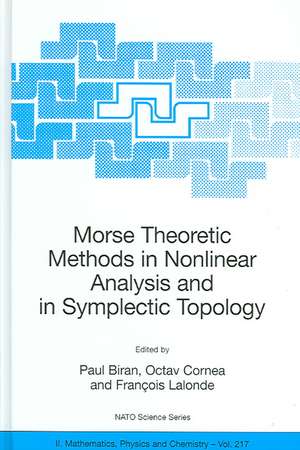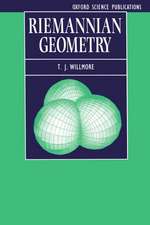Morse Theoretic Methods in Nonlinear Analysis and in Symplectic Topology: NATO Science Series II: Mathematics, Physics and Chemistry, cartea 217
Editat de Paul Biran, Octav Cornea, François Lalondeen Limba Engleză Hardback – 9 ian 2006
| Toate formatele și edițiile | Preț | Express |
|---|---|---|
| Paperback (1) | 1824.49 lei 6-8 săpt. | |
| SPRINGER NETHERLANDS – 9 ian 2006 | 1824.49 lei 6-8 săpt. | |
| Hardback (1) | 1479.38 lei 39-44 zile | |
| SPRINGER NETHERLANDS – 9 ian 2006 | 1479.38 lei 39-44 zile |
Din seria NATO Science Series II: Mathematics, Physics and Chemistry
- 18%
 Preț: 1272.32 lei
Preț: 1272.32 lei - 15%
 Preț: 644.30 lei
Preț: 644.30 lei - 18%
 Preț: 1848.33 lei
Preț: 1848.33 lei - 18%
 Preț: 1235.76 lei
Preț: 1235.76 lei - 15%
 Preț: 649.87 lei
Preț: 649.87 lei - 18%
 Preț: 957.75 lei
Preț: 957.75 lei - 15%
 Preț: 656.58 lei
Preț: 656.58 lei - 18%
 Preț: 1235.43 lei
Preț: 1235.43 lei - 18%
 Preț: 960.13 lei
Preț: 960.13 lei - 18%
 Preț: 1225.79 lei
Preț: 1225.79 lei - 15%
 Preț: 666.41 lei
Preț: 666.41 lei - 18%
 Preț: 1835.07 lei
Preț: 1835.07 lei - 15%
 Preț: 640.71 lei
Preț: 640.71 lei - 18%
 Preț: 954.45 lei
Preț: 954.45 lei - 18%
 Preț: 1227.36 lei
Preț: 1227.36 lei - 15%
 Preț: 646.11 lei
Preț: 646.11 lei - 18%
 Preț: 948.61 lei
Preț: 948.61 lei -
 Preț: 400.10 lei
Preț: 400.10 lei - 18%
 Preț: 959.82 lei
Preț: 959.82 lei - 18%
 Preț: 944.19 lei
Preț: 944.19 lei - 18%
 Preț: 1838.38 lei
Preț: 1838.38 lei - 18%
 Preț: 1222.49 lei
Preț: 1222.49 lei - 18%
 Preț: 939.94 lei
Preț: 939.94 lei - 18%
 Preț: 950.66 lei
Preț: 950.66 lei - 18%
 Preț: 957.44 lei
Preț: 957.44 lei - 15%
 Preț: 656.74 lei
Preț: 656.74 lei
Preț: 1479.38 lei
Preț vechi: 1946.54 lei
-24% Nou
Puncte Express: 2219
Preț estimativ în valută:
283.09€ • 302.71$ • 236.03£
283.09€ • 302.71$ • 236.03£
Carte tipărită la comandă
Livrare economică 14-19 aprilie
Preluare comenzi: 021 569.72.76
Specificații
ISBN-13: 9781402042720
ISBN-10: 1402042728
Pagini: 480
Ilustrații: XIV, 462 p.
Dimensiuni: 210 x 297 x 31 mm
Greutate: 1.09 kg
Ediția:2006
Editura: SPRINGER NETHERLANDS
Colecția Springer
Seria NATO Science Series II: Mathematics, Physics and Chemistry
Locul publicării:Dordrecht, Netherlands
ISBN-10: 1402042728
Pagini: 480
Ilustrații: XIV, 462 p.
Dimensiuni: 210 x 297 x 31 mm
Greutate: 1.09 kg
Ediția:2006
Editura: SPRINGER NETHERLANDS
Colecția Springer
Seria NATO Science Series II: Mathematics, Physics and Chemistry
Locul publicării:Dordrecht, Netherlands
Public țintă
ResearchCuprins
Preface.Contributors. Lectures on the Morse Complex for Infinite-Dimensional Manifolds.-1. A few facts from hyperbolic dynamics.-1.1 Adapted norms .-1.2 Linear stable and unstable spaces of an asymptotically hyperbolic path.-1.3 Morse vector fields.- 1.4 Local dynamics near a hyperbolic rest point ; 1.5 Local stable and unstable manifolds.- 1.6 The Grobman – Hartman linearization theorem.-1.7 Global stable and unstable manifolds.- 2 The Morse complex in the case of finite Morse indices.- 2.1 The Palais – Smale condition.-2.2 The Morse – Smale condition .-2.3 The assumptions .- 2.4 Forward compactness.- 2.5 Consequences of compactness and transversality.- 2.6 Cellular filtrations.- 2.7 The Morse complex.- 2.8 Representation of $\delta$* in terms of intersection numbers.- 2.9 How to remove the assumption (A8).- 2.10 Morse functions on Hilbert manifolds.-2.11 Basic results in transversality theory .- 2.12 Genericity of the Morse – Smale condition.-2.13 Invariance of the Morse complex.- 3 The Morse complex in the case of infinite Morse indices.- 3.1 The program.-3.2 Fredholm pairs and compact perturbations of linear subspaces.- 3.3 Finite-dimensional intersections.-3.4 Essential subbundles.- 3.5 Orientations.- 3.6 Compactness .- 3.7 Two-dimensional intersections .-3.8 The Morse complex.- Bibliographical note.- Notes on Floer Homology and Loop Space Homology.- 1 Introduction.- 2 Main result.-2.1 Loop space homology.-2.2 Floer homology for the cotangent bundle.- 3 Ring structures and ring-homomorphisms.-3.1 The pair-of-pants product.- 3.2 The ring homomorphisms between free loop space Floer homology and based loop space Floer homology and classical homology.-4 Morse-homology on the loop spaces $\Lambda$Q and $\Omega$Q, and the isomorphism.-5 Products in Morse-homology .-5.1 Ring isomorphism between Morse homology and Floer homology.- Homotopical Dynamics in Symplectic Topology.- 1 Introduction .-2 Elements of Morse theory .-2.1 Connectingmanifolds.-2.2 Operations.-3 Applications to symplectic topology.- 3.1 Bounded orbits .-3.2 Detection of pseudoholomorphic strips and Hofer’s norm.- Morse Theory, Graphs, and String Topology.-1 Graphs, Morse theory, and cohomology operations.-2 String topology .-3 A Morse theoretic view of string topology.- 4 Cylindrical holomorphic curves in the cotangent bundle.- Topology of Robot Motion Planning.-1.Introduction .-2 First examples of configuration spaces .-3 Varieties of polygonal linkages.-3.1 Short and long subsets .-3.2 Poincaré polynomial of M(a) .-4 Universality theorems for configuration spaces .-5 A remark about configuration spaces in robotics .-6 The motion planning problem.-7 Tame motion planning algorithms.-8 The Schwarz genus.- 9 The second notion of topological complexity.-10 Homotopy invariance.- 11 Order of instability of a motion planning algorithm.-12 Random motion planning algorithms.- 13 Equality theorem.-14 An upper bound for TC(X).-15 A cohomological lower bound for TC(X) .-16 Examples .-17 Simultaneous control of many systems.-18 Another inequality relating TC(X) to the usual category .-19 Topological complexity of bouquets.-20 A general recipe to construct a motion planning algorithm.-21 How difficult is to avoid collisions in $\mathbb{R}$m? .-22 The case m = 2.- 23 TC(F($\mathbb{R}$m; n) in the case m $\geq$ 3 odd .- 24 Shade.-25 Illuminating the complement of the braid arrangement .-26 A quadratic motion planning algorithm in F($\mathbb{R}$m; n).-27 Configuration spaces of graphs.-28 Motion planning in projective spaces .-29 Nonsingular maps.- 30 TC(($\mathbb{R}$Pn) and the immersion problem.-31 Some open problems.- Application of Floer Homology of Langrangian Submanifolds to Symplectic Topology.- 1 Introduction.- 2 Lagrangian submanifold of $\mathbb{C}$n .-3 Perturbing Cauchy – Riemann equation.- 4 Maslov index of Lagrangian submanifold with vanishing second Betti number.-5Floer homology and a spectral sequence .-6 Homology of loop space and Chas – Sullivan bracket .-7 Iterated integral and Gerstenhaber bracket.- 8 A$_\infty$ deformation of de Rham complex.- 9 S1 equivariant homology of loop space and cyclic A1 algebra .-10 L$_\infty$ structure on H(S1 $\times$ Sn; $\mathbb{Q}$).-11 Lagrangian submanifolds of $\mathbb{C}$3 .-12 Aspherical Lagrangian submanifolds .-13 Lagrangian submanifolds homotopy equivalent to S1 $\times$ S2m .-14 Lagrangian submanifolds of $\mathbb{C}$Pn .- The $\mathcal{LS}$-Index: A Survey.- 1 Introduction .-2 The $\mathcal{LS}$-index.-2.1 Basic definitions and facts.-2.2 Spectra .-2.3 The $\mathcal{LS}$-index .- 3 Cohomology of spectra .-4 Attractors, repellers and Morse decompositions .- 5 Equivariant $\mathcal{LS}$-flows and the G-$\mathcal{LS}$-index.-5.1 Symmetries.-5.2 Isolating neighbourhoods and the equivariant $\mathcal{LS}$-index .-6 Applications.-6.1 A general setting .-6.2 Applications of the $\mathcal{LS}$-index .-6.3 Applications of the cohomological $\mathcal{LS}$-index .-6.4 Applications of the equivariant LS-index.- Lectures on Floer Theory and Spectral Invariants of Hamiltonian Flows.- 1 Introduction .-2 The free loop space and the action functional.-2.1 The free loop space and the S1-action in general.-2.2 The free loop space of symplectic manifolds.-2.3 The Novikov covering.-2.4 Perturbed action functionals and their action spectra.-2.5 The L2-gradient flow and perturbed Cauchy – Riemann equations.-2.6 Comparison of two Cauchy – Riemann equations.-3 Floer complex and the Novikov ring.-3.1 Novikov – Floer chains and the Novikov ring.-3.2 Definition of the Floer boundary map.-3.3 Definition of the Floer chain map.-3.4 Semi-positivity and transversality.-3.5 Composition law of Floer’s chain maps.-4 Energy estimates and Hofer’s geometry.- 4.1 Energy estimates and the action level changes.-4.2Energy estimates and Hofer’s norm.-4.3 Level changes of Floer chains under the homotopy .-4.4 The $\epsilon$-regularity type invariants .-5 Definition of spectral invariants and their axioms.-5.1 Floer complex of a small Morse function.-5.2 Definition of spectral invariants.-5.3 Axioms of spectral invariants.-6 The spectrality axiom.-6.1 A consequence of the nondegenerate spectrality axiom.-6.2 Spectrality axiom for the rational case.-6.3 Spectrality for the irrational case.-7 Pants product and the triangle inequality.-7.1 Quantum cohomology in the chain level.-7.2 Grading convention.-7.3 Hamiltonian fibrations and the pants product .- 7.4 Proof of the triangle inequality.-8 Spectral norm of Hamiltonian diffeomorphisms.-8.1 Construction of the spectral norm.-8.2 The $\epsilon$-regularity theorem and its consequences.-8.3 Proof of nondegeneracy.-9 Applications to Hofer geometry of Ham(M;$\omega$).-9.1 Quasi-autonomous Hamiltonians and the minimality conjecture.- 9.2 Length minimizing criterion via $\rho$(H; 1).-9.3 Canonical fundamental Floer cycles.-9.4 The case of autonomous Hamiltonians.-10 Remarks on the transversality for general (M;$omega$).- A Proof of the index formula.- Floer Homology, Dynamics and Groups.-1 Hamiltonian actions of finitely generated groups.-1.1 The group of Hamiltonian diffeomorphisms.-1.2 The no-torsion theorem.-1.3 Distortion in normed groups .-1.4 The No-Distortion Theorem.-1.5 The Zimmer program.- 2 Floer theory in action.-2.1 A brief sketch of Floer theory .-2.2 Width and torsion.-2.3 A geometry on Ham(M;$\omega$).-2.4 Width and distortion.-2.5 More remarks on the Zimmer program.-3 The Calabi quasi-morphism and related topics.-3.1 Extending the Calabi homomorphism.-3.2 Introducing quasi-morphisms.-3.3 Quasi-morphisms on Ham(M;$\omega$).-3.4 Distortion in Hofer’s norm on Ham(M;$\omega$).- 3.5 Existence and uniqueness of Calabi quasi-morphisms.-3.6 "Hyperbolic" features of Ham(M;$\omega$)? .-3.7 From $\pi$1(M) toDiff0(M;$\Omega$).- Symplectic topology and Hamilton – Jacobi equations.- 1 Introduction to symplectic geometry and generating functions.-1.1 Uniqueness and first symplectic invariants.-2 The calculus of critical level sets.-2.1 The case of GFQI.-2.2 Applications.-3 Hamilton – Jacobi equations and generating functions.-4 Coupled Hamilton – Jacobi equations.-Index.
Caracteristici
Contains up-to date surveys and presentations of some of the "hottest" topics in the subject Some recent significant results are first presented here Among the authors are some of the most important contributors to the field in the last 15 years














